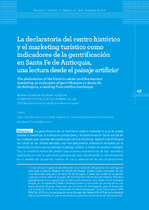La declaratoria del centro histórico y el marketing turístico como indicadores de la gentrificación en Santa Fe de Antioquia, una lectura desde el paisaje artificio
Documentos PDF
Resumen
La gentrificación es un fenómeno urbano mediante el cual se puede analizar e identificar la sustitución poblacional y la transformación física sufrida en las ciudades que ostentan declaratoria de centros históricos. Santa Fe de Antioquia ha sufrido en las últimas décadas una marcada presión urbanística motivada por el marketing turístico que ha alterado el paisaje urbano. A través del análisis cartográfico, se realizó la lectura de predios que poseen características de tipo recreativo, analizando no solo la sustitución poblacional, sino identificando la transformación en el modelo de ocupación, cambio de uso y adecuación de las construcciones que hacen parte del tejido residencial en el área demarcada por la Declaratoria de Monumento de Nacional (Ley 163 de 1959) y la zona urbana. Para ello se analizó, a partir de una metodología multivariada y multitemporal, la cartografía del EOT municipal del 2000 (en mora de ajuste) y con base en ella se reconstituyó una nueva planimetría que evalúa el índice de no ocupación destinado al ocio y la recreación en arquitectura, originariamente con vocación residencial, además de la identificación de predios de tipología comercial, demostrando que la transformación tipológica no se limita a los usos que inventarió la declaratoria, sino que la transformación es, además, en el modelo de ocupación por la presión inmobiliaria a partir de prácticas culturales, confirmando el proceso de la sustitución poblacional y afectando el paisaje cultural del municipio. Gentrification is an urban phenomenon whereby you can analyze and identify the population replacement and the physical transformation occured in cities with declared historical centers. Santa Fe de Antioquia has suffered in recent decades a marked pressure for urban development motivated by tourism marketing that has altered the urban landscape. Through the mapping analysis, was carried out the reading of recreational plots, not only to analyze the population replacement, but also to identify the transformation in the model of occupation, change of use and adaptation of buildings that form part of the residential tissue in the area demarcated by the Declaration of National Monument (Law 163 of 1959) and the urban area. To do so, the EOT municipal cartography of 2000 (in default of adjustment) was analyzed, using a multivariate and multitemporal methodology, and, based on it, a whole new planimetry was reconstituted that evaluates the non-occupancy rate with a destination to leisure and recreation in architecture, although originally conceived for residential purposes. In addition, the identification of business properties was conducted, demonstrating that typological transformation is not limited to the applications inventoried by the declaration, but that it also arises in the model of occupation by realtor pressure from cultural practices, confirming the population replacement process and affecting the cultural landscape of the municipality.
Palabra/s clave
Paisaje
Gentrificación
Marketing turístico
Paisaje artificio e índice de no ocupación
Landscape
Gentrification
Tourism marketing
Artifice landscape
Non-occupancy rate
Colecciones
El ítem tiene asociados los siguientes ficheros de licencia:


